Estimation of Ecological Compensation Standards for Fallow Heavy Metal-Polluted Farmland in China Based on Farmer Willingness to Accept
Abstract
:1. Introduction
2. Study Area
3. Research Methods and Data Sources
3.1. Research Methods
3.2. Questionnaire Design
4. Results and Analysis
4.1. Farmers’ Awareness of Heavy Metal Pollution in Farmland
4.2. Characteristics of WTA of Surveyed Farmers in Jiangxi and Hunan Provinces
4.3. Correlations between Respondents’ Socioeconomic Background Factors and Willingness to Accept
4.4. Farmers’ Preferences for the Method of Compensation
5. Conclusions and Policy Suggestions
5.1. Conclusions
- (1)
- The awareness of heavy metal pollution of farmland in Jiangxi Province was greater than that in Hunan Province.
- (2)
- Ignoring the impact of other factors, the WTA of farmers is 902 (yuan/mu) in Jiangxi Province and 902.26 (yuan/mu) in Hunan Province. Considering the influence of the basic characteristics of the respondents, the parameter estimation method determines that the WTA of farmers is 839.34 (yuan/mu) in Jiangxi Province and 934.39 (yuan/mu) in Hunan Province. There is little difference in the WTA between the two provinces, but the WTA in both regions are higher than the national compensation standards.
- (3)
- The factors affecting the WTA of farmers in Jiangxi Province are gender, education level, average annual income and per capita arable land. The factors affecting the WTA of the farmers in Hunan Province are age, education level, family size, average annual income, per capita arable land area and occupation.
- (4)
- At present, the means and methods of compensation for the implementation of the fallow policy are recognized by most farmers.
5.2. Policy Recommendations
- (1)
- Farmland pollution levels should be stratified, and the appropriate compensation for fallowing should be reasonably determined [12]. The results revealed compensation standards of 839.34 (yuan/mu) in Jiangxi Province and 934.39 (yuan/mu) in Hunan Province. However, the pollution levels are not clearly delineated, and this leads farmers to the perception of pollution is not the same, so the willingness to accept is quite different. The different pollution levels of farmland should be associated with appropriate subsidy levels. To ensure reasonable cost outlays by the national government, more seriously polluted areas should receive more compensation; the farmers’ willingness to participate would be improved, and this approach could save excess expenses.
- (2)
- A diversification approach to realize the ecological compensation mode of heavy metal pollution in farmland areas. The survey found that some respondents preferred the choice of cash as a single compensation means. Others chose other compensation methods. Therefore, the relevant government departments can adapt to the preferences of local residents regarding ecological compensation to develop and provide a variety of forms of ecological compensation, and to improve the heavy metal pollution ecological compensation mechanism of arable land.
- (3)
- The extent of the heavy metal-polluted farmland fallow policy and farmers’ awareness of the hazards of polluted arable land should be increased. As can be seen from this article, the level of education is significantly related to the farmers’ willingness to accept. Therefore, improving the quality of farmers’ education could generate publicity and help them fully understand the strategic importance of heavy metal-polluted land fallowing. In particular, improving the understanding of a new generation of farmers’ with regard to arable land heavy metal pollution is one of the most important tasks for improving the current performance of farmland protection.
5.3. Discussion
Acknowledgments
Author Contributions
Conflicts of Interest
References
- Singh, O.; Labana, S.; Pandey, G. Phytoremediation: An overview of metallic ion decontamination from soil. Appl. Microbiol. Biotechnol. 2003, 61, 405–412. [Google Scholar] [CrossRef] [PubMed]
- Xie, H.L.; He, Y.F.; Xie, X. Exploring the factors influencing ecological land change for China’s Beijing–Tianjin–Hebei region using big data. J. Clean. Prod. 2017, 142, 677–687. [Google Scholar] [CrossRef]
- Xie, H.; Wang, W.; Yang, Z.H.; Choi, Y. Measuring the sustainable performance of industrial land utilization in major industrial zones of China. Technol. Forecast. Soc. Chang. 2016, 112, 207–219. [Google Scholar] [CrossRef]
- Li, Y.M.; Wang, X.; Hao, L.; Liu, Y.; Jiang, L.G. An Analysis on Treatment of Heavy-Metal Soil Contamination: Characteristics and Determinants of Farmers’ Treatment Methods. Chin. Rural Econ. 2017, 1, 58–67. (In Chinese) [Google Scholar]
- Chen, W.P.; Lu, S.D.; Zhang, W.L.; Yi, L.; Jiao, W. Ecological risks and sustainable utilization of reclaimed water and wastewater irrigation. Acta Ecol. Sin. 2014, 34, 163–172. (In Chinese) [Google Scholar]
- Zhao, Q.G.; Teng, Y.; Huang, G.Q. Consideration about Exploring Pilot Program of Farmland Rotation and Fallow System in China. Ecol. Environ. Sci. 2017, 26, 1–5. (In Chinese) [Google Scholar]
- Yang, Q.Y.; Xin, G.X.; Jiang, J.L.; Chen, Z.T. The Comparison and Implications of Crop Rotation and Fallow in the Western Countries and East Asia. Chin. Land Sci. 2017, 31, 71–79. (In Chinese) [Google Scholar]
- Wei, H.B.; Wu, K.N.; Zhao, H.F.; Xia, M.F.; Liu, Q.Q. Spatial distribution characteristics of cultivated land quality gradation in the main grain production area of central China. Res. Sci. 2015, 37, 1552–1560. (In Chinese) [Google Scholar]
- Johnson, K.A.; Dalzell, B.J.; Donahue, M.; Gourevitch, J.; Johnson, D.L.; Karlovits, S.; Keeler, B.; Smith, J.T. Conservation Reserve Program (CRP) lands provide ecosystem service benefits that exceed land rental payment costs. Ecosyst. Serv. 2016, 18, 175–185. [Google Scholar] [CrossRef]
- Kirwan, B.; Lubowski, R.N.; Roberts, M.J. How Cost-Effective Are Land Retirement Auctions? Estimating the Difference between Payments and Willingness to Accept in the Conservation Reserve Program. Am. J. Agric. Econ. 2006, 87, 1239–1247. [Google Scholar] [CrossRef]
- Xie, H.L.; YAO, G.R.; Liu, G.Y. Spatial evaluation of ecological importance based on GIS for environmental management: a case study in Xingguo County of China. Ecol. Indic. 2015, 51, 3–12. [Google Scholar] [CrossRef]
- Wu, Q.; Xie, H.L. A Review and Implication of Land Fallow System Research. J. Res. Ecol. 2017, 8, 223–231. [Google Scholar]
- Baylis, K.; Peplow, S.; Rausser, G.; Simon, L. Agri-environmental policies in the EU and United States: A comparison. Ecol. Econ. 2008, 65, 753–764. [Google Scholar] [CrossRef]
- Cason, T.N.; Gangadharan, L. Auction Design for Voluntary Conservation Programs. Am. J. Agric. Econ. 2004, 86, 1211–1222. [Google Scholar] [CrossRef]
- Suter, J.F.; Poe, G.L.; Bills, N.L. Do Landowners Respond to Land Retirement Incentives? Evidence from the Conservation Reserve Enhancement Program. Land Econ. 2008, 84, 17–30. [Google Scholar] [CrossRef]
- Babcock, B.A.; Lakshminarayan, P.G.; Wu, J.J.; Zilberman, D. The economics of a public fund for environmental amenities: A study of CRP contracts. Am. J. Agric. Econ. 1996, 78, 961–971. [Google Scholar] [CrossRef]
- Feather, P.; Hellerstein, D.; Hansen, L.R. Economic valuation of environmental benefits and the targeting of conservation programs: The case of the CRP. Soc. Sci. Electron. Publ. 1999, 36, 2445–2453. [Google Scholar]
- Ribaudo, M.O. Natural resources and users benefit from the Conservation Reserve Program. In Proceedings of the Symposium on System Theory, Cookeville, TN, USA, 11–13 March 1990; U.S. Department of Agriculture: Washington, DC, USA, 1900; pp. 537–557. [Google Scholar]
- Xie, H.L.; Cheng, L.J.; Lv, T.G. Factors Influencing Farmer Willingness to Fallow Winter Wheat and Ecological Compensation Standards in a Groundwater Funnel Area in Hengshui, Hebei Province, China. Sustainability 2017, 9, 839. [Google Scholar] [CrossRef]
- Hu, Z.; Liu, D.; Kong, D.; Xin, L. Rate calculation of “subsides of grazing prohibition” in grassland eco-compensation based on opportunity cost method. J. Arid Land Resour. Environ. 2017, 2, 63–68. (In Chinese) [Google Scholar]
- Claassen, R.; Cattaneo, A.; Johansson, R. Cost-effective design of agri-environmental payment programs: U.S. Experience in theory and practice. Ecol. Econ. 2008, 65, 737–752. [Google Scholar] [CrossRef]
- Pagiola, S.; Ramirez, E.; Gobbi, J.; de Haan, C.; Ibrahim, M.; Murqueitio, E.; Ruiz, J.P. Paying for the environmental services of silvopastoral practices in Nicaragua. Ecol. Econ. 2007, 64, 347–385. [Google Scholar] [CrossRef]
- Kalacska, M.; Sanchez-Azofeif, G.; Rivard, B.; Calvo-Alvarado, J.C.; Quesada, M. Basedline assessment for environmental services payments from satellite imagery: A case study from Costa Rice and Mexico. J. Environ. Manag. 2008, 88, 348–359. [Google Scholar] [CrossRef] [PubMed]
- Fischel, W.A. The Economics of Zoning Laws: A Property Rights Approach to American Land Use Controls; The Johns Hopkins University Press: Baltimore, MD, USA, 1987. [Google Scholar]
- Liu, X.H.; Yu, X.J. Study on Characteristics and Countermeasures of Heavy Metal Pollution in Yangtze River Delta. Ecol. Econ. 2010, 10, 164–166. (In Chinese) [Google Scholar]
- Hanemann, M.W. Discrete continuous Models of Consumer Demand. Econometrica 1984, 52, 541–562. [Google Scholar] [CrossRef]
- Davis, R.K. Recreation planning as an economic problem. Nat. Res. J. 1963, 3, 239–249. [Google Scholar]
- Hoehn, J.P.; Randall, A. A satisfactory benefit cost indicator from contingent valuation. J. Environ. Econ. Manag. 1987, 14, 1226–1247. [Google Scholar] [CrossRef]
- Chen, J. Study on the Application of CVM in the Social Benefits Valuation of Urban Mass Transit. Adv. Mater. Res. 2013, 734–737, 1625–1628. (In Chinese) [Google Scholar] [CrossRef]
- Park, S.H.; Jung, W.J.; Kim, T.H.; Lee, S.-Y.T. Can Renewable Energy Replace Nuclear Power in Korea? An Economic Valuation Analysis. Nucl. Eng. Technol. 2016, 48, 559–571. [Google Scholar] [CrossRef]
- Liziński, T.; Wróblewska, A.; Rauba, K. Application of CVM method in the evaluation of flood control and water and sewage management projects. J. Water Land Dev. 2015, 24, 41–49. [Google Scholar] [CrossRef]
- Griffiths, J.M.; King, D.W.; Lynch, T. Taxpayer Return on Investment in Florida Public Libraries: Summary Report; State Library and Archives of Florida: Tallahassee, FL, USA, 2010. [Google Scholar]
- Lindhjem, H.; Mitani, Y. Forest owners’ willingness to accept compensation for voluntary conservation: A contingent valuation approach. J. For. Econ. 2012, 18, 290–302. [Google Scholar] [CrossRef]
- Maler, K.G. Handbook of Environmental Economics—Valuing Environmental Changes; Handbook of environmental economics; Blackwell: Oxford, UK, 1995; pp. 125–126. [Google Scholar]
- Vedel, S.E.; Jacobsen, J.B.; Bo, J.T. Forest owners’ willingness to accept contracts for ecosystem service provision is sensitive to additionality. Ecol. Econ. 2015, 113, 15–24. [Google Scholar] [CrossRef]
- Qian, X.; Wang, D.; Ma, L. Benefit Valuation on the Improvement of Street Parks: The CVM Application in Urban Planning. Urban Plan. Forum 2010, 3, 41–50. (In Chinese) [Google Scholar]
- Yuan, S.B.; Wang, H.Z.; Cao, Q. A Case Study of Using CVN to Measure Social Value of Libraries Abroad. Libr. J. 2011, 8, 79–83. (In Chinese) [Google Scholar]
- Li, Y.Z.; Xu, N.W. Studies of the Management System of Yangtze River National Park Based on CVM. Resour. Environ. Yangtze Basin 2016, 1, 1509–1519. (In Chinese) [Google Scholar]
- Yang, X.; Cai, Y.Y.; Zhang, A.L. Estimation of Farmland Eco-Compensation Horizontal Transferring Payment Amount in Wuhan Metropolitan Area—From the perspective of Spillover Ecological Value Measured by Choice Experiment. Resour. Environ. Yangtze Basin 2017, 3, 368–375. (In Chinese) [Google Scholar]
- Yu, Y.H. Farmer’s willingness to accept for maintaining the grain for green: An empirical analysis based on Wanzhou district in Chongqing. J. Arid Land Resour. Environ. 2015, 4, 65–70. (In Chinese) [Google Scholar]
- Zhou, C.; Li, G.P. A Study on the Willingness and the Influencing Factors of Farmers’ Ecological Service Supply—Based on the Survey of 406 Farmers in the Water Resources Area of Southern Shaanxi. Econ. Sci. 2015, 5, 107–117. (In Chinese) [Google Scholar]
- Zheng, X.M.; Bai, T.X. Willingness to Pay for Eco-compensation and Its Influencing Factors of the Residents in the Cities Getting Drinkable Water from Dahuofang Reservoir. Wetl. Sci. 2016, 1, 65–71. [Google Scholar]
- Hu, W.H. Characteristics of grain production in Central China and its influence on national grains. Geogr. Res. 2008, 4, 885–896. (In Chinese) [Google Scholar]
- Zhou, C.; Li, G.P. The Influencing Factors for Willingness to Pay of Payment for Watershed Services: A Case of the Water Receiving Area of Zhengzhou City of the Middle Route Project of the South-North Water Transfer Project. Econ. Geogr. 2015, 6, 38–46. (In Chinese) [Google Scholar]
- Zheng, H.X.; Zhang, L.B. Research on the Standardization of Compensation for the Service of Eco System in River Valley. Environ. Prot. 2006, 35, 241–244. (In Chinese) [Google Scholar]
- Jack, B.K.; Leimona, B.; Ferraro, P.J. A Revealed Preference Approach to Estimating Supply Curves for Ecosystem Services: Use of Auctions to Set Payments for Soil Erosion Control in Indonesia. Conserv. Biol. 2009, 23, 359–367. [Google Scholar] [CrossRef] [PubMed]
- Wang, C.; Cui, L.; Mao, X.; Wen, Y. Comparative studies on the farmers’ willingness to accept eco-compensation in wetlands nature reserve. Acta Ecol. Sinca 2012, 17, 5345–5354. (In Chinese) [Google Scholar] [CrossRef]
- Zhou, Y.; Yang, Q.; Xin, G.; Feng, Y.; Dai, P. The impact of rural households’ concurrent business behaviors response on the housing land-use pattern in poor mountain area: Based on a survey of 568 households in Yunyang County, Chongqing. Geogr. Res. 2010, 10, 1767–1779. (In Chinese) [Google Scholar]
- Yin, K.; Xiao, Y. Empirical Research on Household Willingness and Its Caused Factors for economic compensation of Eco-fallow in the Water-level Fluctuation Zone of the Three Gorges Reservoir Area. Sci. Geogr. Sin. 2015, 9, 1123–1129. (In Chinese) [Google Scholar]
- Li, H.; Cai, Y. Livelihood Diversity and Farmer Participate in Farmland Ecological Compensation Policy Response: The Case Study of Minhang District, Shanghai and Zhangjiagang District, Suzhou. J. Nat. Res. 2014, 10, 1696–1708. (In Chinese) [Google Scholar]
- Shi, P.; Ju, J. Study on ecological migration willingness and its influencing factors: A case of Ankang. Shaanxi. J. Chin. Agric. Univ. 2013, 18, 218–228. (In Chinese) [Google Scholar]
- Zhang, F.; Zhao, X.; Tian, Y.; Hou, C.; Zhang, L. Social Capital and Farmer Willingness to Participate in Ecological Compensation for Three Sites in Gansu. Res. Sci. 2013, 9, 1821–1827. (In Chinese) [Google Scholar]
- Liu, Y.P.; Li, G.; Chen, X.; Jin, J.X.; Zhou, W.S.; Yang, Y.D. Monetary Valuation of the Non-Use Value of Recreational Resources in Huangguoshu Scenically Resort based on WTP and WTA Methods. Res. Sci. 2008, 3, 431–439. (In Chinese) [Google Scholar]
- Makarius, C.S.; Lalika, P.M.; Yonika, M.N.; Goddy, J.S. Willingness to pay for watershed conservation: Are we applying the right paradigm? Ecohydrol. Hydrobiol. 2017, 17, 33–45. [Google Scholar]
- Xia, J.Q.; Luo, Y.M. Some Problems in Current Cultivated Soil Pollution Survey and Assessment in China. Soils 2006, 5, 667–670. (In Chinese) [Google Scholar]
- Xu, D.W.; Liu, C.Y.; Chang, L. A Study on the Disparity of WTP and WTA of the Basin’s Willingness to Compensate: Based on the Residents’ CVM Investigation in the Middle Liaohe Drainage Basin. J. Nat. Res. 2013, 3, 402–409. (In Chinese) [Google Scholar]
- Li, G.D.; Fang, C.L.; Qiu, D.C.; Wang, L.P. Impact of farmer households’ livelihood assets on their options of economic compensation patterns for farmland protection. J. Geogr. Sci. 2014, 2, 331–348. (In Chinese) [Google Scholar] [CrossRef]
- Dai, Q.W. Research on the eco-compensation standards and modes: Taking Maoershan National Nature Reserve of Guangxi Province as an example. Acta Ecol. Sinica 2014, 17, 5114–5123. (In Chinese) [Google Scholar]
- Herzon, I.; Mikk, M. Farmers, perceptions of biodiversity and their willingness to enhance it through agri-environment schemes: A comparative study from Estonia and Finland. J. Nat. Conserv. 2007, 15, 10–25. [Google Scholar] [CrossRef]
- Moon, K.; Cocklin, C. Participation in biodiversity conservation: Motivations and barriers of Australian landholders. J. Rural Stud. 2011, 27, 331–342. [Google Scholar] [CrossRef]
- Sommmerville, M.; Jones, J.P.G.; Rahajaharison, M.; Milner-Gulland, E.J. The role of fairness—Based payment for Environment Services interventions: A case study from Menabe, Madagascar. Ecol. Econ. 2008, 66, 270–274. [Google Scholar]
- Xie, J.; Cai, Y. The impacts of farmer livelihood endowment on participation effectiveness in farmland conservation compensation policy: Chengdu and Suzhou as typical innovational practice areas. Resour. Sci. 2016, 11, 2082–2094. (In Chinese) [Google Scholar]
- Xie, H.L.; Lu, H. Impact of Land Fragmentation and Non-Agricultural Labor Supply on Circulation of Agricultural. Land Use Policy 2017, 68, 355–364. [Google Scholar] [CrossRef]
- Li, H.; Cai, Y. The influence of livelihood capital on intention of protecting cultivated land of farmers: A case study in the three towns in Chengdu area. J. Glaciol. Geocryol. 2015, 2, 545–554. (In Chinese) [Google Scholar]
- Liu, A.; Xu, D.; Xie, F.; Cao, M.; Liu, Z. On Measure of Farmer Livelihoods Capital Based on Factors Affecting Livelihood Strategies—A Case Study of Sichuan Province. J. Southwest China Norm. Univ. 2015, 12, 59–65. (In Chinese) [Google Scholar]
- Yao, G.R.; Xie, H.L. Rural spatial restructuring in ecologically fragile mountainous areas of southern China: A case study of Changgang Town, Jiangxi Province. J. Rural Stud. 2016, 47, 435–448. [Google Scholar] [CrossRef]
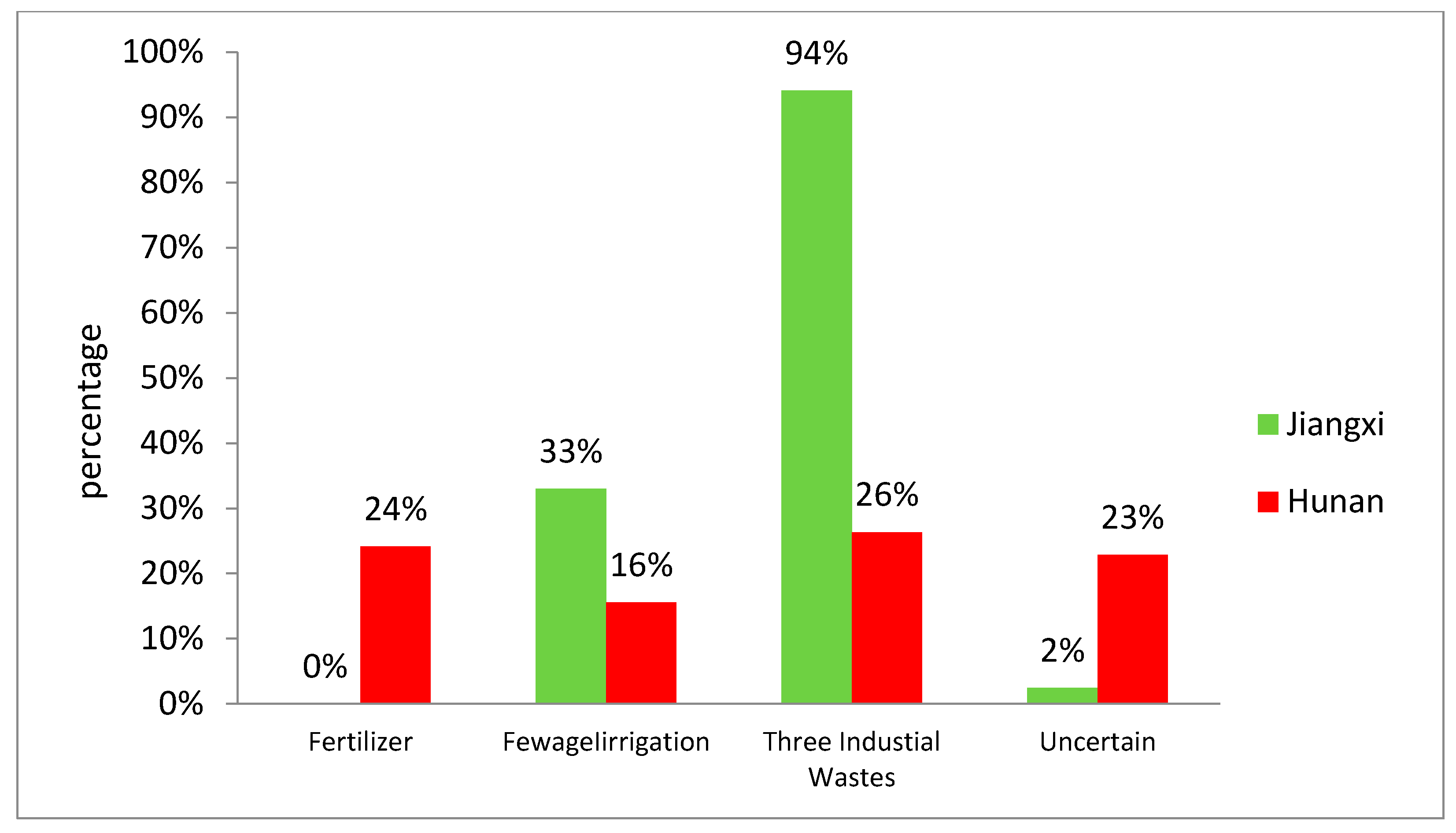
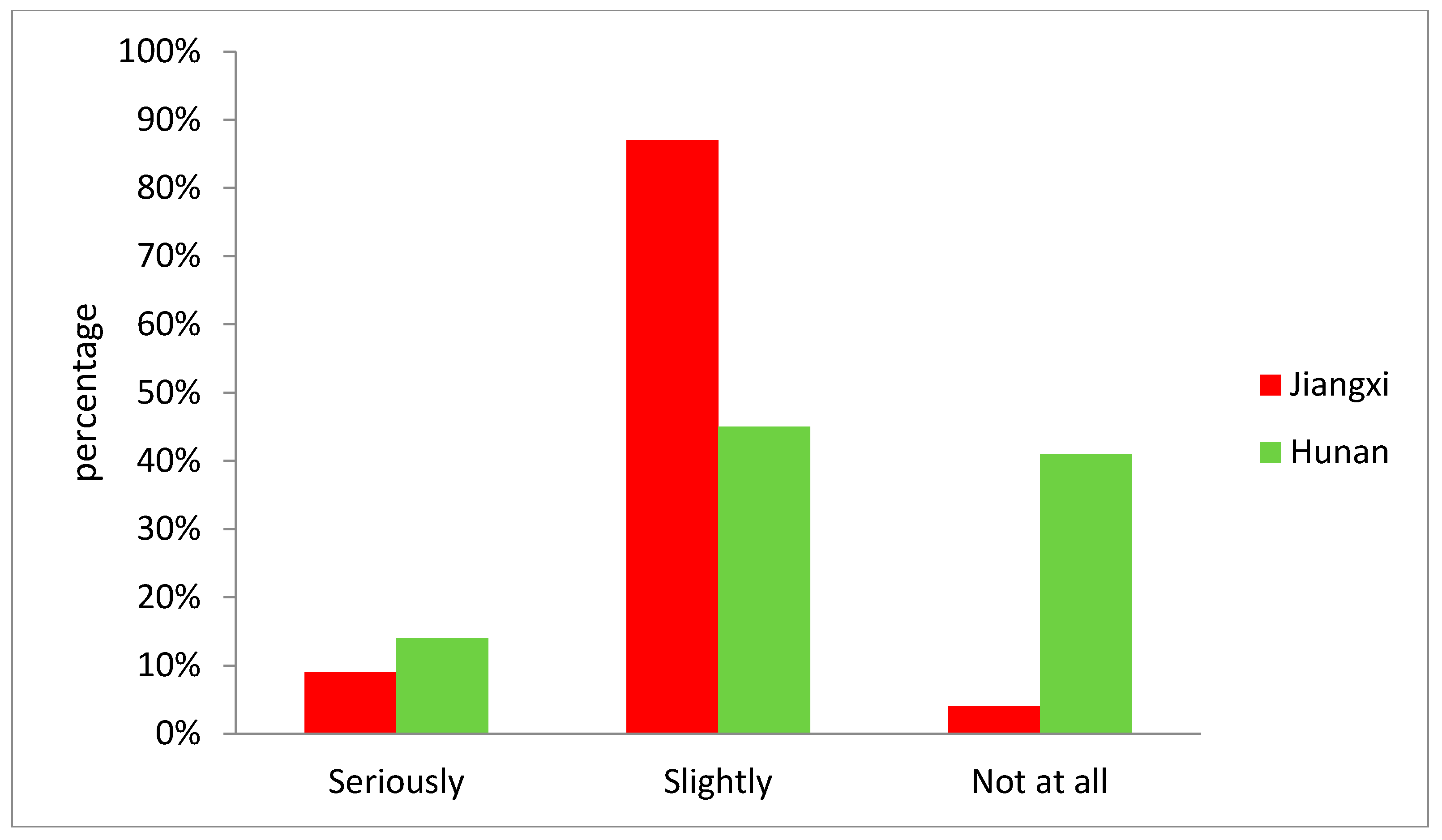
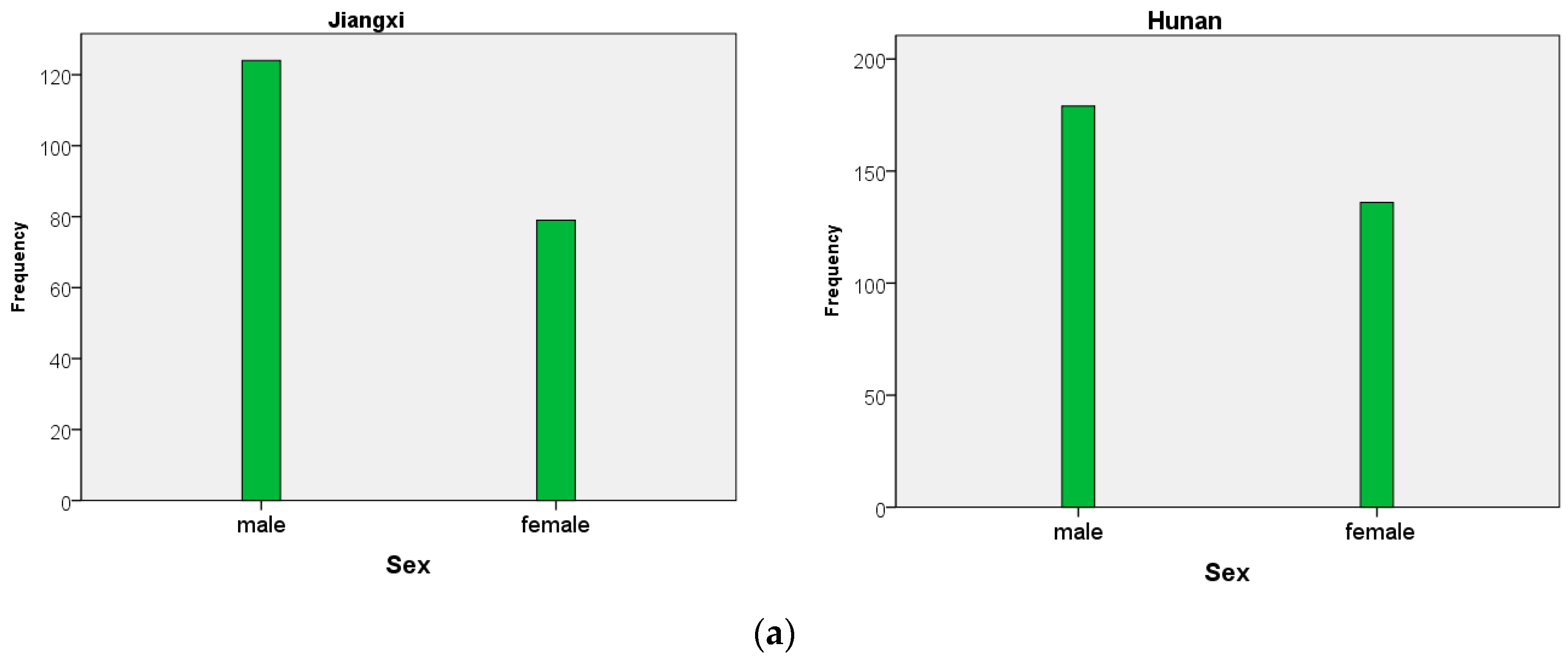
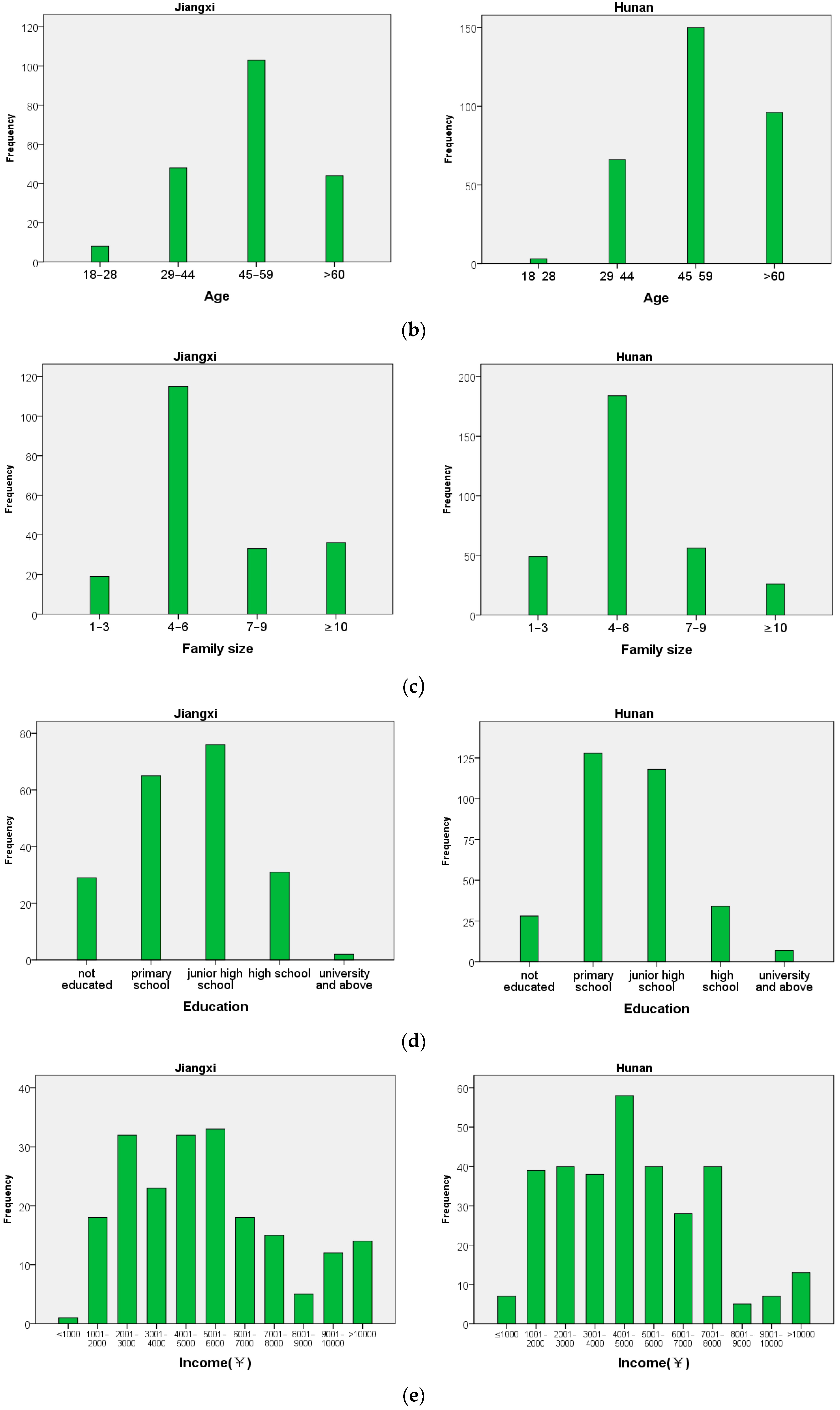
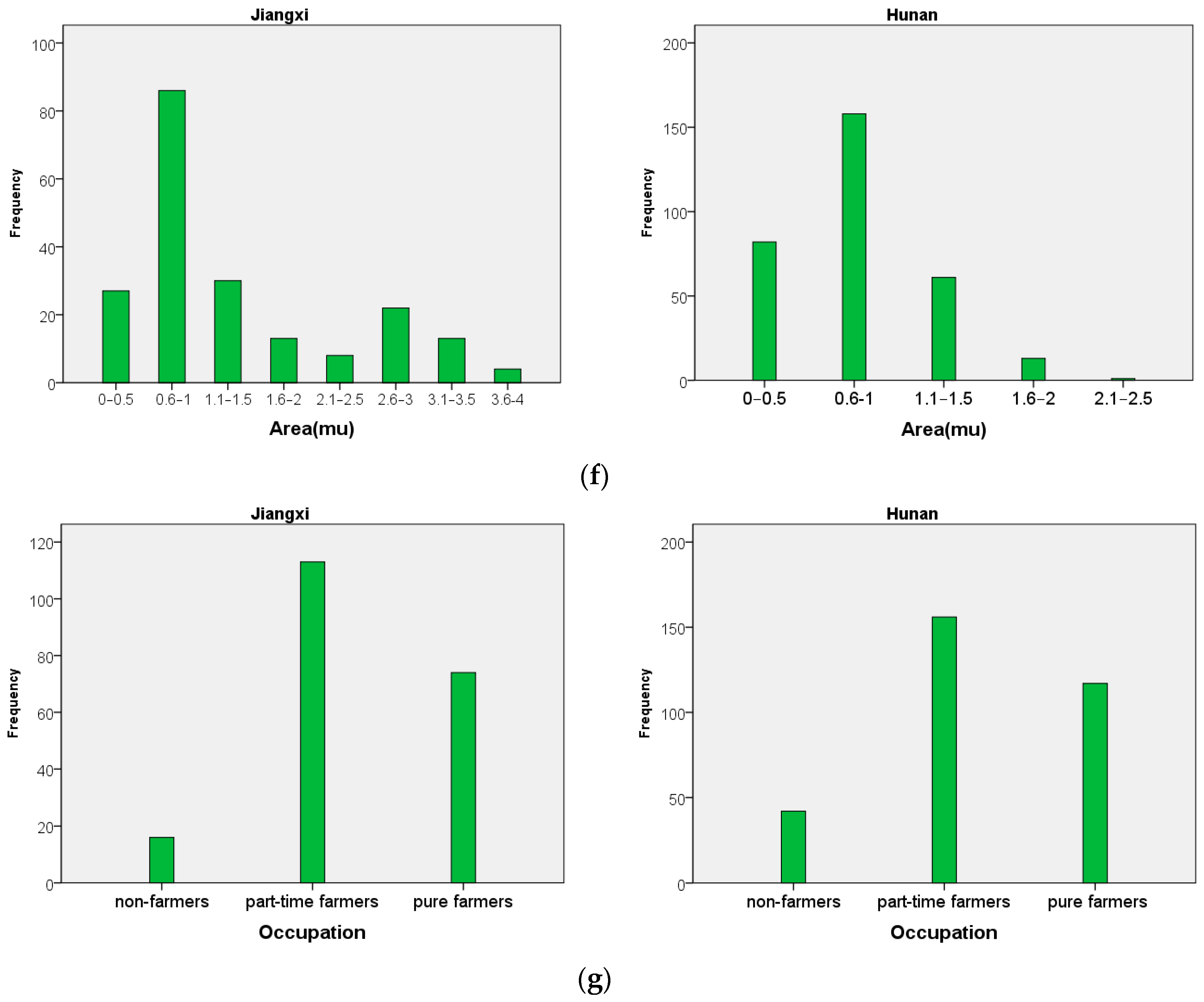

| Jiangxi | Hunan | ||||
|---|---|---|---|---|---|
| WTA (Yuan/mu) | Absolute Frequency (Number) | Relative Frequency (%) | WTA (Yuan/mu) | Absolute Frequency (Number) | Relative Frequency (%) |
| 100 | 1 | 0.5 | 100 | 1 | 0.3 |
| 300 | 9 | 4.4 | 400 | 3 | 1 |
| 400 | 5 | 2.5 | 420 | 4 | 1.3 |
| 500 | 30 | 14.8 | 450 | 3 | 1 |
| 600 | 37 | 18.2 | 500 | 17 | 5.4 |
| 700 | 23 | 11.3 | 600 | 19 | 6 |
| 800 | 7 | 3.4 | 700 | 92 | 29.2 |
| 900 | 4 | 2 | 800 | 34 | 10.8 |
| 1000 | 31 | 15.3 | 900 | 16 | 5.1 |
| 1100 | 1 | 0.5 | 1000 | 86 | 27.3 |
| 1200 | 12 | 5.9 | 1200 | 12 | 3.8 |
| 1300 | 6 | 3 | 1300 | 5 | 1.6 |
| 1400 | 4 | 2 | 1400 | 2 | 0.6 |
| 1500 | 18 | 8.9 | 1500 | 11 | 3.5 |
| 1600 | 3 | 1.5 | 2000 | 9 | 2.9 |
| 1800 | 1 | 0.5 | 10,000 | 1 | 0.3 |
| 2000 | 11 | 5.4 | |||
| Variable | Regression Coefficient (Standard Deviation) | t Test Value | p Value | |||
|---|---|---|---|---|---|---|
| Jiangxi | Hunan | Jiangxi | Hunan | Jiangxi | Hunan | |
| Constant term | 7.481 (79.549) | 6.685 (95.261) | 40.83 | 50.305 | 0.000 | 0.000 |
| Sex (×1) | −0.086 (15.157) | 0.03 (11.387) | −1.953 | 0.971 | 0.052 | 0.333 |
| Age (×2) | 0.021 (9.181) | 0.037 (12.084) | 0.661 | 1.667 | 0.509 | 0.096 |
| Education (×3) | −0.148 (23.37) | −0.071 (12.838) | −4.778 | −3.704 | 0.000 | 0.000 |
| Family size (×4) | 0.006 (3.469) | 0.024 (2.999) | 0.611 | 2.152 | 0.542 | 0.032 |
| Income (×5) | −0.084 (0.005) | −0.061 (0.008) | −7.693 | −9.072 | 0.000 | 0.000 |
| Area (×6) | 0.057 (4.371) | 0.054 (4.833) | 4.34 | 2.893 | 0.000 | 0.004 |
| Occupation (×7) | −0.05 (11.72) | 0.151 (12.823) | −1.558 | 5.31 | 0.121 | 0.000 |
| Jiangxi R2 = 0.646 Hunan R2 = 0.749 | ||||||
| Compensation Means | First Choice (P) | Second Choice (P) | ||
|---|---|---|---|---|
| Hunan | Jiangxi | Hunan | Jiangxi | |
| Cash | 237 | 116 | 39 | 30 |
| Technical support | 3 | 5 | 9 | 19 |
| Food subsidies | 10 | 12 | 57 | 38 |
| Social security | 19 | 40 | 43 | 40 |
| Arrange employment | 28 | 10 | 15 | 20 |
| Preferential policies | 2 | 3 | 3 | 6 |
| Land compensation | 1 | 4 | 3 | 9 |
© 2017 by the authors. Licensee MDPI, Basel, Switzerland. This article is an open access article distributed under the terms and conditions of the Creative Commons Attribution (CC BY) license (http://creativecommons.org/licenses/by/4.0/).
Share and Cite
Xie, X.; Xie, H.; Shu, C.; Wu, Q.; Lu, H. Estimation of Ecological Compensation Standards for Fallow Heavy Metal-Polluted Farmland in China Based on Farmer Willingness to Accept. Sustainability 2017, 9, 1859. https://doi.org/10.3390/su9101859
Xie X, Xie H, Shu C, Wu Q, Lu H. Estimation of Ecological Compensation Standards for Fallow Heavy Metal-Polluted Farmland in China Based on Farmer Willingness to Accept. Sustainability. 2017; 9(10):1859. https://doi.org/10.3390/su9101859
Chicago/Turabian StyleXie, Xue, Hualin Xie, Cheng Shu, Qing Wu, and Hua Lu. 2017. "Estimation of Ecological Compensation Standards for Fallow Heavy Metal-Polluted Farmland in China Based on Farmer Willingness to Accept" Sustainability 9, no. 10: 1859. https://doi.org/10.3390/su9101859
APA StyleXie, X., Xie, H., Shu, C., Wu, Q., & Lu, H. (2017). Estimation of Ecological Compensation Standards for Fallow Heavy Metal-Polluted Farmland in China Based on Farmer Willingness to Accept. Sustainability, 9(10), 1859. https://doi.org/10.3390/su9101859






